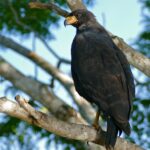Great black hawks, also known as Buteogallus anthracinus, use a variety of courtship behaviors to attract a mate. These behaviors include soaring with flights in a wave-like motion, dangling of the legs, flying in tandem with the female sometimes flying upside down to lock or touch talons with the male, and males feeding females as part of courtship. Additionally, males bring sticks to the nest with ceremony and vocalization.
Courtship Displays of Great Black Hawks
Great black hawks engage in several courtship displays to attract a mate:
-
Soaring with Wave-like Flights: The hawks soar with flights that have a wave-like motion, often dangling their legs during these displays.
-
Tandem Flights: The male and female hawks fly in tandem, calling and dangling their legs. The female sometimes flies upside down to lock or touch talons with the male.
-
Feeding the Female: As part of courtship, the male great black hawk will feed the female.
-
Nest Building: Males bring sticks to the nest with ceremony and vocalization, as part of the courtship process.
Monogamous Relationships and Nest Defense
 Image source: Great Black Hawk by Bernard DUPONT
Image source: Great Black Hawk by Bernard DUPONT
Great black hawks are socially monogamous, with some pairs studied in Arizona staying together for several successive nesting seasons. When pairs return to their breeding territory, they immediately begin flight displays over the area.
During the nesting period, great black hawks are highly aggressive in defending their nest. They chase away most raptors, as well as ravens and vultures, from the nest area. Their aggressive flight displays directed at intruders look similar to their courtship displays.
Habitat and Prey of Great Black Hawks
Great black hawks inhabit riparian forests in canyons and deserts in the United States and northern Mexico. They specialize in hunting aquatic prey from perches, usually from tree limbs that overhang the water or from rocks in the streambed.
Their diet consists mainly of fish, reptiles, small mammals, and invertebrates. They are versatile predators that watch for prey from perches and then drop onto it. They may also “herd” prey into shallower water by walking and waving their wings.
Conclusion
The great black hawk uses a variety of courtship behaviors, including soaring, tandem flights, feeding the female, and nest building, to attract a mate. These hawks are socially monogamous and highly aggressive in defending their nests. They inhabit riparian forests and specialize in hunting aquatic prey from perches.
References:
– Feathered Photography Blog
– University of the West Indies
– Audubon
– All About Birds
– Nature My View


